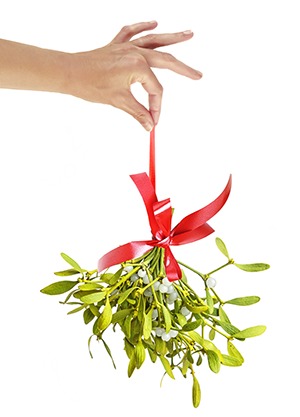It’s that season when many pin a bouquet of mistletoe in their doorway for that magical ritual of kissing underneath its bounty. While there’s wonderful lore behind this annual tradition, mistletoe is also a very useful medicinal herb.
Lore
Dating back to 16th century England, kissing under the mistletoe was probably an custom adopted by the Christians from other earlier rituals that honored this plant, although it was rarely alluded to until the 18th century. Customarily, a man and a woman who meet under the hanging mistletoe were obliged to kiss – and still are today. Shakespeare called it “the baleful mistletoe” because in a Scandinavian legend, Balder, the god of peace, was slain with an arrow made of mistletoe. He was restored to life at the request of the other gods and goddesses and after mistletoe was given to Freya, the goddess of love, beauty and fertility, who proclaimed that everyone passing under it should receive a kiss so the branch would become an emblem of love, and not of hate. This ritual probably sourced from the Celtic Druids who held that mistletoe possessed life-bestowing properties, protected against evil, was an antidote for poisons, cured illnesses, and enhanced fertility, especially since it could blossom even in the winter. They especially esteemed mistletoe growing in oak trees because it was much rarer, and they would harvest it in ritual with a golden sickle at a particular phase of the moon at the beginning of the year (the winter solstice) if they had visions directing them to seek it. Greek legends also associated mistletoe with peace as any enemy stepping under mistletoe was required to lay down their arms and declare a truce until the next day. The “golden bough” of Aeneas, ancestor of the romans, written about in the Aenid by Virgil is thought to be mistletoe.
A Parasite
Mistletoe is a parasitic plant that grows on the branches of trees and forms pendant bushes. It actually sends forth a thread-like root that pierces the bark and roots in the growing wood of its host tree, using its sap and so forth as its own food. Mistletoe fruit – the red berries – are highly toxic and should not be eaten!
Western Mistletoe
There are more than 30 species of mistletoe and not all are safe. Phoradendron flavescens, the mistletoe typically used in the U.S. during the holidays, contains a toxic protein, phoratoxin, which slows the heartbeat, weakens the heart muscle, and can cause contact dermatitis. It should only be used as a decoration (or by an experienced practitioner, if even then). Viscum album (Loranthaceae family), the European mistletoe, however, has many wonderful uses. It is mainly employed as a nervine, antispasmodic and narcotic. It has been traditionally used for the “falling sickness,” or epilepsy, and other convulsive nervous disorders, including St. Vitus’ Dance, delirium, and hysteria, although it may also be used for sciatica, neuralgia, and nervous debility. It is also used to lower blood pressure and for this must be taken awhile to see results and is best combined with other herbs such as eucommia (Eucommia ulmoides, du zhong). For hypertension it treats the accompanying symptoms of headache and tinnitus. All of these symptoms translate in Chinese medicine as Liver Wind and Liver Yang Rising. Mistletoe has also been used for gout, rheumatism, tachyarrhythmia (it slows the heart down), angina, palpitations, and menorrhagia. As well, it is given homeopathically for epilepsy, sciatica, convulsions, tearing pains, asthma, and a feeling of suffocating when lying on the left side. These uses of mistletoe match how the Chinese use it – to dispel Wind-Dampness as well as for hypertension – so it seems that the EuropeanViscum album could possibly be used similarly to the Chinese Taxillus chinensis (see below). Today many use mistletoe for cancer, which originated with Rudolph Steiner who likened the parasitical aspect of mistletoe to cancer. There is no conclusive evidence at this point that mistletoe reduces cancer, however. Western Mistletoe Contraindications: Pregnancy, lactation, diabetes as it can modify glucose regulation; some say to avoid it if taking antidepressants or if there’s hyperthyroidism; some say even Viscum album should only be used by experienced practitioners. Dose: Fresh plant tincture : chronic – 1:5: 10-20 drops TID (60 drops mas/day); up to 75 drops/day short term for an acute crisis.
Chinese Mistletoe
Chinese medicine uses the species Taxillus chinensis (formerly Loranthus chinensis or sang ji sheng), the mistletoe growing on the mulberry tree. It is used to expel Wind-Dampness, tonify the Liver and Kidneys, nourish the Yin and Blood, and quiet the fetus in pregnancy. It treats low back and muscle pain, arthritis, rheumatism, and hypertension. It treats weakness and atrophy of the sinews and bones, and numbness,. Because it also tonifies Yin and Blood, it is used to nourished dry, scaly skin due to Blood Deficiency or stop uterine bleeding during pregnancy. It also promotes lactation. The Chinese also use the species Viscum coloratum (hu ji sheng) or colored mistletoe, which is a parasite on a different kind of tree than taxilli. It is also used to expel Wind Dampness and also tonifies the Liver and Kidneys, strengthens the sinews and bones, and calms the fetus. It is stronger at expelling Wind-Damp and so used more for painful obstruction, although it also treats lower back and leg pain and weakness, and hypertension. Because of their similarities, it’s highly possible that Chinese mistletoe could be used for epilepsy and nervous debility, like Western mistletoe is used. Chinese Mistletoe Contraindications: None noted Dose: 9-15 g

